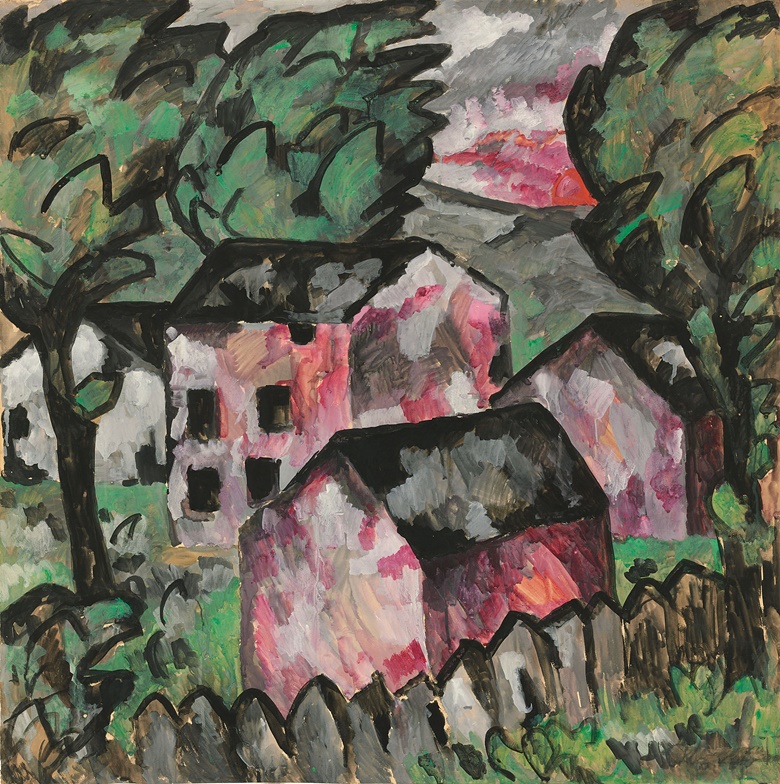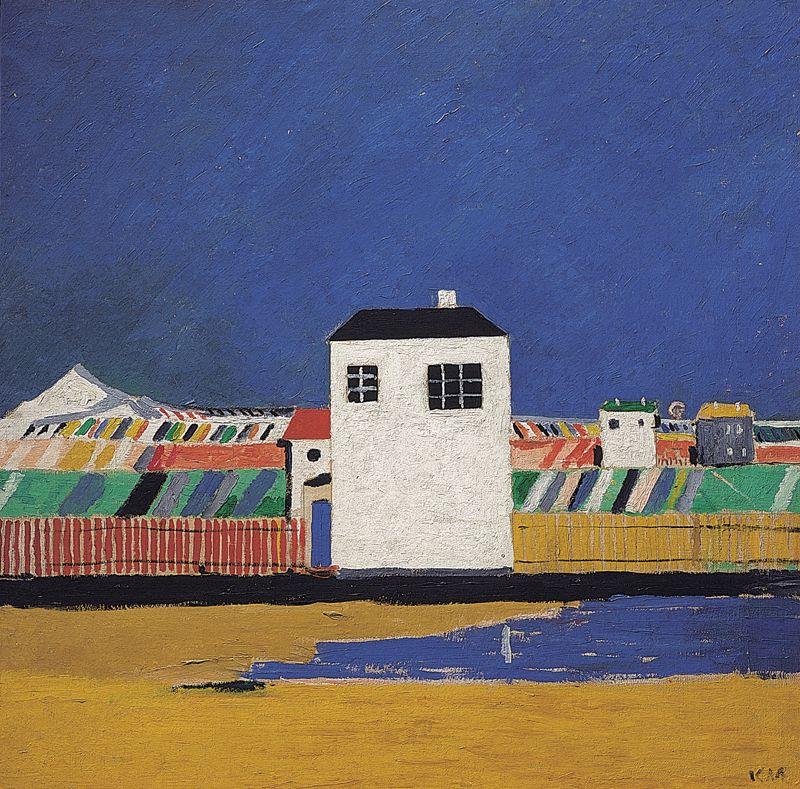For a good novel featuring Malevich's art read:
Hammer by
Reed, Joe Mungo, author.
Publication Date
2022
Also see Malevich at Auction I

Kazimir Malevich, Suprematist Composition, 1916, oil on canvas. © Christie’s Images Limited 2018. Kazimir Malevich’s Suprematist Composition, 1916, will lead Christie’s Evening Sale of Impressionist and Modern Art (estimate upon request). Suprematist Composition is among the groundbreaking abstract paintings executed by Malevich that would forever change the course of art history. The present canvas was last sold at auction in November 2008, when it established the world auction record for the artist, which it continues to hold today.* One decade later, Suprematist Composition is expected to set a new benchmark for the artist when it is offered at Christie’s New York on May 15.Loic Gouzer, Co-Chairman, Post-War and Contemporary Art, remarked: “Malevich’s work provided a gateway for the evolution of Modernism. Malevich pushed the boundaries of painting to a point far beyond recognition, forever changing the advancement of art. Without the Suprematist Composition paintings, the art being made today would not exist as we now know it.”
Max Carter, Head of Department, Impressionist and Modern Art, New York, continued: “Malevich’s Suprematist abstractions didn’t break with the past so much as articulate the future. What an honor to offer Suprematist Composition, 1916 which has lost nothing of its revolutionary power in the century since it was painted, this spring.”
On 17th December 1915, the Russo-Polish artist Kazimir Malevich opened an exhibition of his new ‘Suprematist’ paintings in the Dobychina Art Bureau in the recently renamed city of Petrograd. These startling, purely geometric and completely abstract paintings were unlike anything Malevich, or any other modern painter, had ever done before. They were both a shock and a revelation to everyone who saw them. Malevich’s Suprematist pictures were the very first purely geometric abstract paintings in the history of modern art. They comprised solely of simple, colored forms that appeared to float and hover over plain white backgrounds. Nothing but clearly-organized, self-asserting painted surfaces of non-objective/non- representational form and color, these pictures were so radically new that they seemed to announce the end of painting and, even perhaps, of art itself.
Suprematist Composition is one of the finest and most complex of these first, truly revolutionary abstract paintings. Comprised of numerous colored, geometric elements seeming to be dynamically caught in motion, it epitomizes what Malevich defined as his ‘supreme’ or ‘Suprematist’ vision of the world. The painting is not known to have been a part of the exhibition in the Dobychina Art Bureau but is believed to date from this same period of creative breakthrough and, if not included, was, presumably painted very soon after the show closed in January 1916.
It is clear, from the frequency with which Malevich later exhibited the picture, that he thought very highly of the painting. Malevich subsequently chose, for example, to include Suprematist Composition in every other major survey of his Suprematist pictures made during his lifetime. These exhibitions ranged from his first major retrospective in Moscow in 1919 to the great travelling retrospective showcasing much of his best work that he brought to the West in 1927. It was as a result of his last exhibition held in Berlin that Suprematist Composition came to form part of the extraordinarily influential group of Malevich’s paintings that remained in the West and represent so much of his creative legacy.
Hidden in Germany throughout much of the 1930’s, Suprematist Composition and the other works from this great Berlin exhibition, were ultimately to become part of the highly influential holdings of Malevich’s work in the Museum of Modern Art in New York and the Stedelijk Museum in Amsterdam. Until 2008, when it was restituted to the heirs of Malevich’s family in agreement with the Stedelijk museum, Suprematist Composition was on view in Amsterdam as part of the Stedelijk’s unrivalled collection of the artist’s work.

Kazimir Malevich, Landscape, 1911. Gouache on paper laid down on board, 41 3/4 x 41 3/4 in. (106 x 106 cm.). Estimate: £7,000,000-10,000,000. © Christie’s Images Limited 2018.Kazimir Malevich’s Landscape (1911, estimate: £7,000,000-10,000,000) will be a major highlight of Christie’s Impressionist and Modern Art Evening Sale on 20 June 2018, part of ‘20th Century at Christie’s’, a series of auctions taking place from 15 to 21 June 2018. The monumental, square-format landscape is from ‘The Red Series’, a group of works characterised by gestural brush strokes and an expressive use of colour, referencing both Fauvism and Cubism, and anticipating Malevich’s move towards Suprematism.
Landscape was first exhibited in the ‘Moscow Salon’ in February / March 1911. It was subsequently shown the following year in St. Petersburg as part of ‘The Union of Youth’, where Malevich represented a radical collective known as ‘Donkey’s Tail’.
In 1927, he was invited to Germany to show his work for the first time outside Russia and brought with him the best works of his career to date. Landscape was one such work and remained in Berlin after Malevich returned to Russia. Due to the rise of totalitarianism in Germany and in his home country, the artist lost control of his works abroad before he died in 1935.
Landscape resurfaced after the war and was acquired by the Kunstmuseum Basel, where it hung for over 50 years, before being restituted to the heirs of the artist. It is now being offered from a private collection and represents the first time that work has come to auction in two generations. Landscape will be exhibited in London from 15 to 20 June 2018.
Landscape is a ‘pure’ landscape painting whose motif of peasant dwellings surrounded by stylized treetops is borrowed from Russian primitive art. The use of colour to sculpt the forms represented recalls the techniques employed by Cézanne, while the block-like depiction of the buildings nods towards the Cubist compositions of Braque and Picasso. By distilling these diverse visual references, Malevich has created a powerful and profoundly unique work of art. He himself stated that ‘one was obliged to move both along the line of primitive treatment of phenomena, and along the line of Cézanne to cubism.’ The red-hot gleam on the horizon is a direct depiction of the sun, one of the unique features of the painting that foretells the primacy of colour that would define Suprematism.
In the early 1930s, Malevich returned to creating ‘pure’ landscapes, producing

Landscape with five houses,

Landscape with a white house,
A RARE SUPREMATIST CANVAS BY MALEVICH
A strong group of early Abstract works are led by Kazimir Malevich’s Suprematist Composition with Plane in Projection of 1915 (estimate $12/$18 million) – a prime example of the artist’s “Suprematist” paintings, which are extremely rare. Coined by the artist during his exhibition at the 0.10: Last Futurist Exhibition of Paintings in Petrograd in 1915 – in which the present work most likely hung – the term refers to Malevich’s fascination with the impact of color and form. For the exhibition, Malevich displayed 39 paintings detached from figurative subject matter. The appearance of Suprematist Composition with Plane in Projection of 1915 in the May auction is particularly timely: Malevich is a focus of the Royal Academy of Art’s recent exhibition Revolution: Russian Art 1917-1932.
Kazimir Malevich, Mystic Suprematism (Black Cross on Red Oval), 1920-22 $37,770,000(£24,549,886)

.jpg)